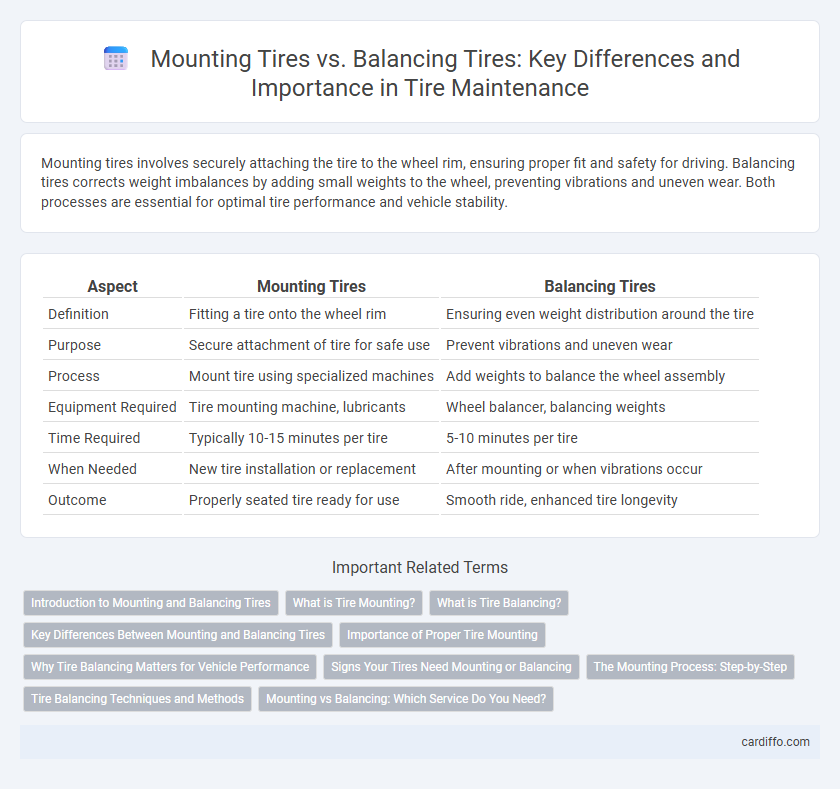Mounting tires involves securely attaching the tire to the wheel rim, ensuring proper fit and safety for driving. Balancing tires corrects weight imbalances by adding small weights to the wheel, preventing vibrations and uneven wear. Both processes are essential for optimal tire performance and vehicle stability.
Table of Comparison
| Aspect | Mounting Tires | Balancing Tires |
|---|---|---|
| Definition | Fitting a tire onto the wheel rim | Ensuring even weight distribution around the tire |
| Purpose | Secure attachment of tire for safe use | Prevent vibrations and uneven wear |
| Process | Mount tire using specialized machines | Add weights to balance the wheel assembly |
| Equipment Required | Tire mounting machine, lubricants | Wheel balancer, balancing weights |
| Time Required | Typically 10-15 minutes per tire | 5-10 minutes per tire |
| When Needed | New tire installation or replacement | After mounting or when vibrations occur |
| Outcome | Properly seated tire ready for use | Smooth ride, enhanced tire longevity |
Introduction to Mounting and Balancing Tires
Mounting tires involves securely fitting the tire onto the wheel rim to ensure proper alignment and airtight seal, which is crucial for vehicle safety and performance. Balancing tires focuses on evenly distributing the tire and wheel weight to prevent vibrations and uneven tire wear, enhancing driving comfort and extending tire lifespan. Both processes are essential for optimal tire function, with mounting establishing a physical fit and balancing maintaining dynamic stability during motion.
What is Tire Mounting?
Tire mounting is the precise process of fitting a tire onto a wheel rim, ensuring a secure and airtight seal between the tire bead and the rim flange. This step is crucial for maintaining proper tire pressure and optimal performance, requiring specialized equipment to stretch the tire over the rim without damaging the components. Proper tire mounting lays the foundation for safe driving and prevents premature tire wear caused by improper installation.
What is Tire Balancing?
Tire balancing is the process of equalizing the weight distribution of a tire and wheel assembly to ensure smooth rotation and prevent vibrations. It involves attaching small weights to the wheel rim to counterbalance any heavy spots, improving vehicle stability and tire longevity. Proper tire balancing enhances driving comfort, reduces uneven tire wear, and contributes to better fuel efficiency.
Key Differences Between Mounting and Balancing Tires
Mounting tires involves securely fitting the tire onto the wheel rim using specialized equipment, ensuring airtight sealing and proper alignment. Balancing tires focuses on equalizing the weight distribution around the tire and wheel assembly to prevent vibrations and uneven wear during driving. Proper mounting ensures safety and tire integrity, while precise balancing enhances ride comfort and extends tire lifespan.
Importance of Proper Tire Mounting
Proper tire mounting ensures a secure fit between the tire and wheel rim, preventing air leaks and potential tire damage. Accurate mounting reduces the risk of uneven tire wear, maintaining optimal traction and extending tire lifespan. Neglecting proper mounting can compromise vehicle safety, leading to vibration, poor handling, and increased fuel consumption.
Why Tire Balancing Matters for Vehicle Performance
Tire balancing ensures even distribution of weight around the wheel, preventing vibrations and uneven tire wear that can compromise vehicle control and safety. Properly balanced tires reduce strain on suspension components, improve fuel efficiency, and extend tire lifespan. Failing to balance tires can result in wobbling, poor handling, and increased driver fatigue, affecting overall driving performance.
Signs Your Tires Need Mounting or Balancing
Uneven tire wear, vibrations at specific speeds, and difficulty steering often signal the need for tire balancing, which redistributes weight for smoother rotation. Signs that tires require mounting include visible sidewall damage, loose tires on the rim, or noticeable punctures that disrupt the seal between tire and wheel. Regular maintenance involving both mounting and balancing ensures optimal tire performance, safety, and extended tire lifespan.
The Mounting Process: Step-by-Step
The mounting process begins with removing the old tire and cleaning the rim surface to ensure a proper seal. Next, the new tire is carefully aligned with the wheel and fitted using specialized mounting equipment to avoid damage. The final step involves inflating the tire to the recommended pressure, preparing it for the balancing procedure to ensure smooth driving performance.
Tire Balancing Techniques and Methods
Tire balancing techniques involve the precise distribution of weight around a tire and wheel assembly to ensure smooth rotation and reduce vibrations. Common methods include static balancing, where the tire is balanced on a single plane using bubble balancers, and dynamic balancing, which uses computerized machines to detect imbalances in multiple planes and apply corrective weights accordingly. Advanced techniques such as spin balancing and laser balancing provide enhanced accuracy by simulating real driving conditions and adjusting weight placement to optimize tire performance and longevity.
Mounting vs Balancing: Which Service Do You Need?
Mounting tires involves securely fitting the tire onto the wheel rim, ensuring proper alignment and airtight sealing, which is crucial for safe driving and tire performance. Balancing tires addresses uneven weight distribution around the tire and wheel assembly to prevent vibrations and improve vehicle handling. Choosing between mounting and balancing depends on whether you're installing new tires or maintaining optimal ride quality after installation.
Mounting tires vs balancing tires Infographic

 cardiffo.com
cardiffo.com